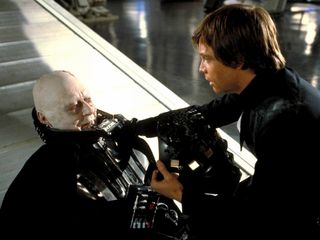Ethics and Morality
Darth Vader: The Value of Redemptive Sacrifice
As a mark of mythic storytelling, Vader pokes the public consciousness.
Posted November 25, 2015
The Star Wars character of Darth Vader is perhaps the most widely known villain in our pop culture history, and his ominous presence is felt in a variety of cinematic, television, and comic book outlets. Regardless of how he appears, what makes him an impactful anti-hero is that he wasn’t always "bad." Those who know his fall from grace see a good, altruistic man performing countless acts of heroism. Yet, his tortured obsession for protecting the ones he cares about takes him down an alternate path. His legend has grown over time as toys, films, books, video games and television shows have revealed his story as the ultimate Dark Lord of the Sith.
With the three prequel films (1999-2005) that preceded the original Star Wars trilogy (1977-1983) that introduced us to the hero story of Luke Skywalker, creator George Lucas provided a backstory that deconstructed Luke’s archenemy—his own father. The Star Wars saga continues with yet another trilogy where a 3rd generation Skywalker will carry the Force into a 3rd generation of super-fans!
I’m often queried about my fascination with such a singular character of a space opera film franchise. I can only start by saying that our family saw the original “Star Wars” at a drive-in theatre in when I was 5. By the end of the next year, I had a Darth Vader poster and action figure in my room. I would regularly raid my Dad’s toolbox to use a retractable tape measure as my lightsaber. It clipped onto my waistband and I would make it sound like it was powering up and down. I chased my sister around the house with it every day until we were both outfitted with toy replicas. Until they were broken, our light-up toys slammed back and forth throughout 1980 as we jumped on our parent’s bed in the dark and dueled it out in front of the mirror.
A Mark of Mythic Storytelling
As the “Chosen One” in the story’s mythology, Anakin Skywalker’s higher calling was to bring balance to the Force and restore peace to the galaxy from the warring religions of Jedi (light side) and Sith (dark side). Seduced by promises of power to fulfill a destiny far beyond the scope of his gifts, he chooses a path that departs from his socialization and training in the culture in which he was raised. To him, that new choice was not wrong, but right and necessary to be in accordance with his new belief system. As this plays out, Anakin must transcend the order from Jedi to Sith and back again to fully restore the balance. This phenomenon was a complicated experiment in temptation, morality, and justice.

In the late 70s, the character of Darth Vader was not sympathetic or understandable. He was monstrous, menacing and a mystery. We only knew that Obi-Wan Kenobi told Luke Skywalker that he and his father had fought side-by-side as Jedi Knights and that Darth Vader, also a Jedi, betrayed and killed his father during the war.
It wasn’t until The Empire Strikes Back in 1980, when we see a glimpse of the back of his head without his armor while he’s in his meditation chamber that showed us that there is a “guy” inside. He became less villainous and his monstrous nature diminished over time and the more we knew about his story through Empire (‘80) and Return of the Jedi (‘83), he was eventually painted as a hero protagonist or tragedy. Vader’s master manipulated him, constantly testing his loyalty and assuring that he “held the tiger by the tail.” His methods depict an alteration over time, either leading to punishment, un-heroic success, or redemption. It is through this lens, and over the course of six films, that we understand Vader’s heroic behavior by killing his master to save his son. Darth Vader’s redemption, in the end, was not really the issue of light side or dark side. He was always a hero but caught in the tragedy of noble cause corruption—a confusing moral paradox where he sought significance and meaning through his unique gifts.
We see the same thing over and again within our own cultural belief systems, religions, and government. All of us understand it as a significant phenomenon because we are tested on it daily. We are faced with choices and behaviors that we must justify as an end or a means to an end. In the beginning, the troublesome issue in the Vader/Skywalker paradox is not whether a right could be made, but that the choice was always between two wrongs. In choosing to do either wrong, he inevitably taints himself. On the other hand, do the choices carry a measure of rightness and thus force a decision between them?
The character of Darth Vader casts a shadow, today, across the panorama of modern mythology. The impact of his story has come to represent something meaningful to fans. Like superheroes, I tend to take journeys with our fictional heroes and find courage and inspiration in them. However, with Darth Vader his value comes through the good vs. evil duality motif because villains show us the truth of who we are.
Vader had a profound impression on the public consciousness and, although it was different for everyone, he was an interesting character to dissect. His mask symbolized his separation from humanity—a popular horror movie device with mythological roots going back to the masks of the pharaohs. The suit and helmet recalled the nobility of the knights or samurai, bound to codes of honor. The idea of Vader and where he fit into the fans’ minds elevated him to cult status before anyone had seen the film in 1977 (Torres, 2015).
Who’s Right and What’s Right? The Consequences of Moral Relativity
In the latter films, Lucas delivered on Vader’s potential as a villain with more depth. In Star Wars, he was rage-filled and indiscriminately evil. In Empire, he confirmed for us his underlying humanity--he was Luke’s father with complex goals and motivations.
By Jedi in 1983, Luke Skywalker’s willingness to die a good person than fall to the dark side inspires Vader to find the courage and strength that his own son called him to recollect prior to handing him over to his master. With his final act to look upon his son with his “own eyes” and a promise to tell his daughter that Luke was right about him, Vader fully returns to the man he once was. Luke’s story was one of the Hero’s Journey, Vader’s one of tragedy—a life surrendered to evil. Only at the end does he find redemption in an ultimate act of self-sacrifice.

As Darth Vader, the value of redemptive sacrifice was the return—a reward! A tangible recognition that expressed himself through the realization that by doing well for another, he advanced his own humanity. Any hero may sacrifice himself as a physical realization of the truth that you and I are “one”. Interlocking lives was the crux of philosopher Arthur Schopenhauer’s metaphysical symbols of death transcendence. From it, a hero may sacrifice himself so that others may live but, in essence, we continue to live on in them—a unity with all life. With it, however, begs questions in the results of the sacrifice. Is it uncertain? Will those we save go on to do what is right? Sacrificial consequences are not certain and the transcendence itself is a risk. Perhaps the next trilogy will test this theory.
By experiencing death and destruction, Vader’s son, himself, learned to value life and it inspired him to continue making sacrifices in new and habitual ways. In many respects, the redemptive value of Darth Vader was that the two (he and his son) were bound to one another by sharing resources.
During my time in law enforcement, I gained a keen empathy for this character I followed in the science-fiction and fantasy world which inspired an affinity beyond mere nostalgia. I would see so many people who made bad choices: drugs, alcohol, abuse—and then forced to live with it—in Vader! People can become stuck in vicious cycles of mental illness, addictions, post-traumatic stress, and abusive relationships. Sometimes all they need to find a way out is for someone to reach out a hand—to connect with them on a human level—as Luke does with Vader.
The hopelessness of a lost soul resonates with us in the real world. Even if our stakes are not so high or the tragedies so great, everyone can relate to the journey and there is value in sharing our own light during another's dark times.
Copyright © by Brian A. Kinnaird
References and Recommended Reading:
Hollingdale, R.J. (1970). Arthur Schopenhauer: Essays and aphorisms (trans.). Penguin Books: London, England.
Lucas, G. (1977). Star Wars. [Motion Picture]. United States: Lucasfilm.
Lucas, G. (1980). Star Wars: The Empire Strikes Back. [Motion Picture]. United States. Lucasfilm.
Lucas, G. (1983). Star Wars: Return of the Jedi. [Motion Picture]. United States. Lucasfilm.
Torres, K. (Winter, 2015). Darth Vader. Geek-Out. Yorba Linda, CA.




